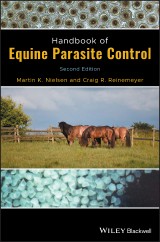Details
Handbook of Equine Parasite Control
2. Aufl.
|
CHF 158.00 |
|
| Verlag: | Wiley-Blackwell |
| Format: | EPUB |
| Veröffentl.: | 29.03.2018 |
| ISBN/EAN: | 9781119382812 |
| Sprache: | englisch |
| Anzahl Seiten: | 256 |
DRM-geschütztes eBook, Sie benötigen z.B. Adobe Digital Editions und eine Adobe ID zum Lesen.
Beschreibungen
<p><i>Handbook of Equine Parasite Control, Second Edition</i> offers a thorough revision to this practical manual of parasitology in the horse. Incorporating new information and diagnostic knowledge throughout, it adds five new sections, new information on computer simulation methods, and new maps to show the spread of anthelmintic resistance. The book also features 30 new high-quality figures and expanded information on parasite occurrence and epidemiology, new diagnostics, treatment strategies, clinical significance of infections, anthelmintic resistance, and environmental persistence.</p> <p>This second edition of <i>Handbook of Equine Parasite Control</i> brings together all the details needed to appropriately manage parasites in equine patients and support discussions between horse owners and their veterinarians. It offers comprehensive coverage of internal parasites and factors affecting their transmission; principles of equine parasite control; and diagnosis and assessment of parasitologic information. Additionally, the book provides numerous new case histories, covering egg count results from yearlings, peritonitis and parasites, confinement and deworming, quarantine advice, abdominal distress in a foal, and more.</p> <ul> <li>A clear and concise user-friendly guide to equine parasite control for veterinary practitioners and students</li> <li>Fully updated with new knowledge and diagnostic methods throughout</li> <li>Features brand new case studies</li> <li>Presents 30 new high-quality figures, including new life-cycle charts</li> <li>Provides maps to show the spread of anthelmintic resistance</li> </ul> <p><i>Handbook of Equine Parasite Control</i> is an essential guide for equine practitioners, veterinary students, and veterinary technicians dealing with parasites in the horse.</p>
<p>List of Contributors ix</p> <p>Preface to the First Edition xi</p> <p>Preface to the Second Edition xiii</p> <p>Acknowledgements xv</p> <p><b>Section I Internal Parasites and Factors Affecting Their Transmission 1</b></p> <p>1 Biology and Life Cycles of Equine Parasites 3</p> <p>2 Pathology of Parasitism and Impact on Performance 25</p> <p>3 Environmental Factors Affecting Parasite Transmission 45<br /> <i>Contributing authors: Dave Leathwick and Christian Sauermann</i></p> <p>4 Host Factors Affecting Parasite Transmission 55</p> <p>5 Parasite Factors Affecting Parasite Transmission 61</p> <p><b>Section II Principles of Equine Parasite Control 69</b></p> <p>6 Decreasing Parasite Transmission by Non‐chemical Means 71</p> <p>7 Pharmaceutical Approaches to Parasite Control 81<br /> <i>Contributing authors: Dave Leathwick and Christian Sauermann</i></p> <p>8 Anthelmintic Resistance 99</p> <p><b>Section III Diagnosis and Assessment of Parasitologic Information 111</b></p> <p>9 Diagnostic Techniques 113</p> <p>10 Detection of Anthelmintic Resistance 141</p> <p>11 Evaluating Historical Information 149</p> <p>12 Synopsis of Evidence‐Based Parasite Control 155</p> <p><b>Section IV Case Histories 163</b></p> <p>Case 1: Mystery Drug 165</p> <p>Case 2: Pyrantel Efficacy Evaluation 167</p> <p>Case 3: Egg Count Results from Yearlings 169</p> <p>Case 4: Peritonitis and Parasites 173</p> <p>Case 5: Confinement after Deworming 177</p> <p>Case 6: Abdominal Distress in a Foal 179</p> <p>Case 7: Quarantining Advice 181</p> <p>Case 8: Diarrhea and Colic 183</p> <p>Case 9: Foal Diarrhea 187</p> <p>Case 10: Oral Lesion 191</p> <p>Case 11: Skin Lesion 193</p> <p>Case 12: Legal Case 197</p> <p>Case 13: Repeated Egg Counts 199</p> <p>Case 14: Repeated Colic 201</p> <p>Case 15: Ivermectin Efficacy 205</p> <p>Case 16: Anthelmintic Treatments in Foals 207</p> <p>Case 17: Ivermectin Egg Reappearance 209</p> <p>Case 18: Name That Worm 211</p> <p>Case 19: Parasite Control for Yearlings 213</p> <p>Case 20: Reaction to Treatment 215</p> <p>Case 21: Anthelmintic Toxicosis? 217</p> <p>Case 22: Deworming Program Adjustment? 219</p> <p>Glossary 221</p> <p>Index 225</p>
<p>"Overall, the book would be handy and very helpful for the equine practitioner, as well as veterinary parasitologists and students. It is an excellent contribution to the field of equine parasitology." - <i>Veterinary Parasitology<br /><br /></i></p> <p>“The second edition of <i>Handbook of Equine Parasite Control</i> is an enjoyable and easy-to-read reference on the control of internal parasites in equids. The authors describe parasites and host behavior with clarity and wit, which is unexpected yet definitely appreciated…. In my opinion, this is a must-read book for any veterinarian who treats horses.” - JAVMA | SEP 15, 2020 | VOL 257 | NO. 6</p>
<p><b>Martin K. Nielsen, DVM, PhD, DipACVM,</b> is Associate Professor and Schlaikjer Professor in Equine Infectious Disease at the M.H. Gluck Equine Research Center in the Department of Veterinary Science at the University of Kentucky in Lexington, Kentucky, USA. <p><b>Craig R. Reinemeyer, DVM, PhD, DipACVM,</b> is a Founder and President of East Tennessee Clinical Research in Rockwood, Tennessee, USA.
<p><i>Handbook of Equine Parasite Control, Second Edition</i> offers a thorough revision to this practical manual of parasitology in the horse. Incorporating new information and diagnostic knowledge throughout, it adds five new sections, new information on computer simulation methods, and new maps to show the spread of anthelmintic resistance. The book also features 30 new high-quality figures and expanded information on parasite occurrence and epidemiology, new diagnostics, treatment strategies, clinical significance of infections, anthelmintic resistance, and environmental persistence. <p>This second edition of <i>Handbook of Equine Parasite Control</i> brings together all the details needed to appropriately manage parasites in equine patients and support discussions between horse owners and their veterinarians. It offers comprehensive coverage of internal parasites and factors affecting their transmission; principles of equine parasite control; and diagnosis and assessment of parasitologic information. Additionally, the book provides numerous new case histories, covering egg count results from yearlings, peritonitis and parasites, confinement and deworming, quarantine advice, abdominal distress in a foal, and more. <ul> <li>A clear and concise user-friendly guide to equine parasite control for veterinary practitioners and students</li> <li>Fully updated with new knowledge and diagnostic methods throughout</li> <li>Features brand new case studies</li> <li>Presents 30 new high-quality figures, including new life-cycle charts</li> <li>Provides maps to show the spread of anthelmintic resistance</li> </ul> <p><i>Handbook of Equine Parasite Control</i> is an essential guide for equine practitioners, veterinary students, and veterinary technicians dealing with parasites in the horse.
Diese Produkte könnten Sie auch interessieren:

Nursery Rearing of Nonhuman Primates in the 21st Century

von: Gene P. Sackett, Gerald Ruppenthal, Kate Elias

CHF 236.00
















